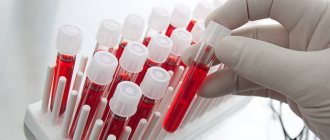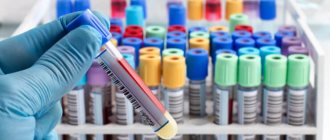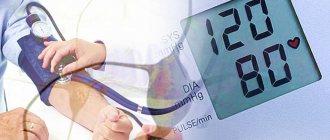Norm and deviations
Laboratory analysis is used to determine blood sugar levels. Indicators differ depending on the patient’s age, food intake, and the condition of the pancreas. Therefore, it is important to take tests in the morning on an empty stomach. Regardless of the gender of the patient, the indicator for an adult is 3.3-5.5 mmol/l.
If the study was carried out according to all the rules, but the indicator slightly exceeds its values, reaching up to 7 mmol/l, this means that the patient has diabetes. In this case, the doctor prescribes repeated blood tests and additional tests, since the results could be influenced by various factors:
- stress,
- taking large amounts of carbohydrates at night,
- a viral or infectious disease that the patient has developed at the moment.
To confirm the diagnosis, an additional analysis is used - a load of glucose solution. After taking it, studies are carried out every hour. After each period of time, the amount of sugar in the blood should decrease. Normally, in a healthy person, this shows the preserved ability of insulin to deliver glucose to target organs.
Sugar norm by age
For each age after birth, there are different indicator standards. In a child, the value is less because the organs have not fully developed. In old age, the norms become higher, the pancreas partially loses its function.
| Age | Blood glucose level, mmol/l |
| Newborns | 2,5-4,5 |
| From 1 month to 13 years | 3,3-5,7 |
| From 14 to 55 years | 3,3-5,5 |
| From 56 to 90 years | 4,5-6,5 |
| From 90 years and above | 4,3-6,8 |
Normal values increase in women during pregnancy. This is determined by the heavy load on the internal organs and the restructuring of hormonal levels. If the value is elevated excessively, this indicates gestational diabetes mellitus. Nutrition correction is necessary. After pregnancy is completed, in most cases the indicators return to normal. If after 3 months they do not change, insulin therapy is prescribed.
Sugar level in diabetes
In people with diabetes mellitus who are on insulin replacement therapy, the value of the indicator changes. Most often it does not return completely to normal. The changes are described in the table.
| Index | For diabetes | In healthy people |
| Fasting glucose, mmol/l | 5,1-7 | 3,2-5,5 |
| Glucose 1 hour after eating, mmol/l | Up to 9 | Up to 8 |
| Glycosylated hemoglobin,% | Up to 7 | 4,5-5,5 |
Blood sugar above 12 mmol/l means that a person has a disorder in the body. This may be hyperglycemia associated with inflammatory diseases of the pancreas or diabetes mellitus. If the value exceeds 12 mmol/l, this affects the patient’s well-being. He feels weak, tired, lethargic, dizzy. Possible loss of consciousness.
Such indicators are observed in people who violate diet rules or neglect medications. If the indicator is not reduced, this can lead to complications:
- a sharp increase in blood pressure,
- sclerosis of the vascular wall,
- disease of internal organs (liver, kidneys, heart).
Why doesn't insulin work?
Sometimes patients suffering from insulin-dependent diabetes mellitus ask the doctor a question: “I regularly give injections, but my sugar levels remain at 10, 12, 13, 14, 16, 17, 18, 19, 20 mmol/l, what should I do, what does this mean?” ? There may be several reasons for the ineffectiveness of insulin therapy:
- the dosage of the drug is incorrectly selected;
- non-compliance with diet and injections;
- improper storage of insulin ampoules;
- mixing different insulins in one syringe;
- injection site, violation of technique;
- injections in places of compaction;
- wiping the skin with alcohol before administering the drug;
- quickly removing the needle from the skin fold after the injection.
To each patient who suffers from insulin-dependent type 1 diabetes, the doctor explains how to properly inject, in which area of the body and other subtleties. For example, wiping the skin with an alcohol solution reduces the effectiveness of the drug; after insulin is injected, you must wait 10 seconds before removing the needle, otherwise the medicine may leak out.
If you constantly inject into the same place, lumps will form, and the drug will be absorbed more slowly when it enters such an area. You need to know how to properly mix different types of insulins, which of them can be combined and which cannot. The opened ampoule must be stored in the refrigerator.
In case of incorrect dosage, it is necessary to make a correction in consultation with your doctor. You cannot do this on your own, as hypoglycemia may develop. If the patient has poor vision and cannot correctly see the amount of the drug, it is necessary to ask relatives for help.
Expert opinion
Guseva Yulia Alexandrova
Specialized endocrinologist
Ask a Question
Read also: The hormone insulin and its role in the human body
Possible reasons
There are various reasons for exceeding the indicator up to 12 mmol/l.
These include:
- Neglecting medications prescribed by the doctor. The patient may periodically forget to inject insulin, which causes an increase in levels.
- No low-carbohydrate, low-fat diet. Incorrect calculation of the glycemic index of foods.
- Infectious and viral diseases leading to an increase in the body's defenses. This requires additional energy, which is generated from glucose in the blood.
- Severe stress, leading to increased release of hormones into the blood that stimulate the formation of sugar.
- Impaired liver function, leading to the production of glucose reserves using enzymes.
Ketoacidosis
Northern Lights - diabetes prevention (consultation) More details
Our readers write
Topic: Conquered diabetes
From: Galina S. ( [email protected] )
To: Administration aboutdiabetes.ru
At the age of 47, I was diagnosed with type 2 diabetes. In a few weeks I gained almost 15 kg. Constant fatigue, drowsiness, feeling of weakness, vision began to fade.
And here is my story
When I turned 55, I was already steadily injecting myself with insulin, everything was very bad... The disease continued to develop, periodic attacks began, the ambulance literally brought me back from the other world. I always thought that this time would be the last...
Everything changed when my daughter gave me an article to read on the Internet. You can’t imagine how grateful I am to her for this. This article helped me completely get rid of diabetes, a supposedly incurable disease. Over the last 2 years I have started to move more; in the spring and summer I go to the dacha every day, grow tomatoes and sell them at the market. My aunts are surprised how I manage to do everything, where so much strength and energy comes from, they still can’t believe that I’m 66 years old.
Who wants to live a long, energetic life and forget about this terrible disease forever, take 5 minutes and read this article.
Go to article>>>
What is dangerous about high blood sugar, what can happen if glucose is at the level of 10, 12, 14, 16, 17, 18, 20, 21, 22, 30 mmol/l and what does this mean? High blood sugar levels that remain at the same level for a long time can lead to the development of ketoacidosis. The body tries to utilize excess glucose by breaking down fats, which results in the formation of ketone bodies and intoxication of the body.
Symptoms of ketoacidosis:
- general weakness, malaise;
- first, frequent urination in large volumes, then anuria;
- the smell of acetone when breathing;
- nausea, vomiting, tense abdominal wall, abnormal stool;
- noisy breathing;
- increased irritability;
- lethargy, drowsiness;
- headache;
- glucose level 20, 21, 25, 26, 30 mmol/l;
- ketone bodies are present in the blood and urine;
- impaired visual acuity;
- drowsiness.
Ketoacidosis must be treated in a hospital setting. Insulin therapy is prescribed, the deficiency of fluid in the body, potassium and other missing microelements is replenished, and the acid-base balance is restored.
Diagnosis of diabetes mellitus
Laboratory testing is used to diagnose diabetes. It can be done both at home and in the laboratory. In order for the result to be correct, the following are prepared for the study:
- the night before the test, you should not consume excessive amounts of carbohydrates,
- In the morning the test is taken on an empty stomach, immediately after sleep,
- The patient should not be nervous before the examination.
For home testing, a glucometer is used. This is a device that pricks the patient's finger. A little biological fluid is dripped onto a special test strip. The exact amount of glucose in the blood is displayed on the screen.
If the test is done in a laboratory, the nurse collects blood from a finger or vein and delivers it to the laboratory assistant. The indicator can be determined separately or using a general blood test.
The type of diabetes mellitus is determined by measuring insulin. If it is absent in the blood, it is type 1. If it is there, but it does not perform a function, it is the second type.
Diet during pregnancy
A diet with high sugar levels for pregnant women is not particularly different from the diet of ordinary diabetics, but special emphasis should be placed on frequent meals. After all, you need to eat every three hours, and the last meal should be no later than 3-4 hours before bedtime.
As for the menu itself, if high sugar levels are observed during pregnancy, it is necessary to adjust the diet so that lean foods (foods of natural origin) predominate in it.
Among confectionery products, you need to choose sweets with sweeteners or limit yourself to biscuits. Prohibited foods include fatty meats and fish, mushrooms, as well as foods prepared by frying or smoking.
What to do to lower blood sugar
In addition to insulin therapy and treatment with hypoglycemic medications (according to medical indications), the following methods for improving the condition of diabetes are used: a healthy diet and optimal physical activity (preferably in the fresh air).
Correcting diabetes with proper nutrition involves consciously avoiding foods that are harmful to health and including in the diet foods that contribute to the health of the pancreas and the body as a whole.
Emphasis should be placed on natural products containing natural vitamins and other essential substances. These are fresh vegetables that are good for diabetes because they have a low GI.
Recipe for healthy vegetable juice for diabetes
The recipe is borrowed from the book “Raw Vegetable Juices” by Norman Walker (founder of juice therapy).
There are vegetables that diabetics should pay special attention to as they improve the functioning of the pancreas. . Foods that improve diabetes include:
Foods that improve diabetes include:
The program “Let Them Talk” talked about diabetes
Why do pharmacies offer outdated and dangerous drugs, while hiding the truth about the new drug from people...
- green beans;
- spinach;
- Brussels sprouts;
- carrot;
- lettuce leaves.
In order to get the maximum benefit from eating these vegetables, it is recommended to make fresh juice from them (using a screw juicer, which allows you to preserve the beneficial properties of the products). This juice will also contain fiber, which improves bowel function.











